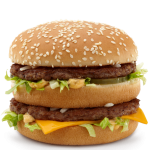The smell of French fries wafts out of the kitchen. Hamburger meat sizzles on the hot grill. Surrounded by red and orange menus, greeted by excited cashiers, customers ponder over what to order, putting fast food advertising methods to the test.
Fast food companies spend at least $1.6 billion a year in the United States on advertising, according to the Federal Trade Commission. In order to maximize sales, companies have utilized various advertising methods.
“We don’t normally think about how fast food companies appeal to product placement,” communication applications teacher Kami Faldyn said. “They will place commercials at times when a specific audience is going to be seeing it.”
According to senior Kathryn Wright, fast food companies have implemented the feelings evoked from color into their advertising techniques.
“They tend to use reds and yellows,” she said. “They mix together to give an orange, which actually promotes hunger.”
How companies intend to be seen can also be reflected in the environment restaurants place customers. Junior La’Lexus King said things such as a smile from a cashier or a happy actor in a commercial affect customers’ perception of fast food products.
“The way the workers talk to you, they’re cheerful and happy like their food is the best thing ever,” she said. “It’s contagious and makes you want to go buy it too. Fast food places make their restaurants look very bright and cool, like everyone’s just having fun.”
A recent study by the Rudd Center for Food Policy & Obesity found that companies make an effort to target younger children and teenagers. By instilling a sense of familiarity around their product, fast food companies are able to gain lifetime customer loyalty.
“The other day my husband said [he didn’t] want to take the kids to play at McDonald’s,” Faldyn said. “[He’d] rather take them to play at [an inflatable play place], and then go have a hamburger at McDonald’s. He didn’t want them to associate the two together and think, ‘oh play time means that we go eat at McDonald’s’.”
While play areas mainly target customers at their childhood, fast food companies have also tried appealing to a teenage demographic, resorting to the Internet. The Rudd Center’s study reported that McDonald’s has 13 websites all geared towards different age groups, receiving an overall 249,000 teenage visitors per month.
“When a company is online it’s just ‘look at our website’,” Faldyn said. “At this point if a company doesn’t have a website then there’s something wrong with the company, and so people evaluate other organizations off of that.”
Internet advertising allows companies to spread their products quickly across social networking sites like YouTube and Facebook. In 2009, Burger King began a Facebook campaign, The Whopper Sacrifice. Users could receive a free Whopper coupon after deleting 10 Facebook friends. Viral sensations like this let companies insert their product, including slogans and jingles, into every facet of customers’ lives.
“Everyone can sing the McDonald’s jingle and everyone knows what the next word is, ‘I’m loving it’,” Faldyn said. “The faster someone can remember it, the catchier the tune, the wittier the wording, the better. That is what’s going to sell. That is what people are going to remember.”
According to Franchise Disclosure Documents, in the past three years the value of the fast food market has grown four percent in Texas, second only to California.






